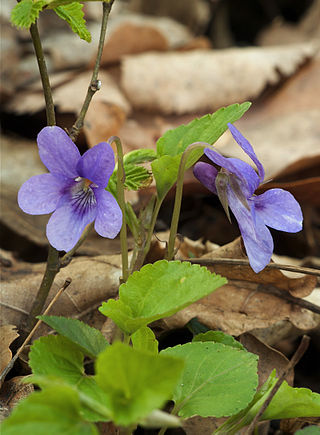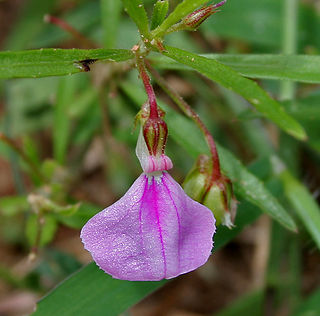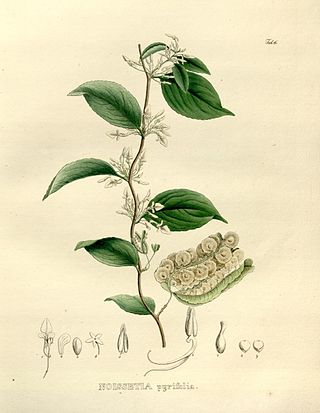
The Malpighiales comprise one of the largest orders of flowering plants, containing about 36 families and more than 16,000 species, about 7.8% of the eudicots. The order is very diverse, containing plants as different as the willow, violet, poinsettia, manchineel, rafflesia and coca plant, and are hard to recognize except with molecular phylogenetic evidence. It is not part of any of the classification systems based only on plant morphology. Molecular clock calculations estimate the origin of stem group Malpighiales at around 100 million years ago (Mya) and the origin of crown group Malpighiales at about 90 Mya.

Thelypteridaceae is a family of about 900 species of ferns in the order Polypodiales. In the Pteridophyte Phylogeny Group classification of 2016, it is placed in the suborder Aspleniineae. Alternatively, the family may be submerged in a very broadly defined family Aspleniaceae as the subfamily Thelypteridoideae.

Viola is a genus of flowering plants in the violet family Violaceae. It is the largest genus in the family, containing over 680 species. Most species are found in the temperate Northern Hemisphere; however, some are also found in widely divergent areas such as Hawaii, Australasia, and the Andes.

The Salicaceae are the willow family of flowering plants. The traditional family included the willows, poplars, aspens, and cottonwoods. Genetic studies summarized by the Angiosperm Phylogeny Group (APG) have greatly expanded the circumscription of the family to contain 56 genera and about 1220 species, including the tropical Scyphostegiaceae and many of the former Flacourtiaceae.

Violaceae is a family of flowering plants established in 1802, consisting of about 1000 species in about 25 genera. It takes its name from the genus Viola, the violets and pansies.

Petrosaviaceae is a family of flowering plants belonging to a monotypic order, Petrosaviales. Petrosaviales are monocots, and are grouped within the lilioid monocots. Petrosaviales is a very small order composed of one family, two genera and four species accepted in 2016. Some species are photosynthetic (Japonolirion) and others are rare, leafless, chlorophyllous, mycoheterotrophic plants (Petrosavia). The family is found in low-light montane rainforests in Japan, China, Southeast Asia and Borneo. They are characterised by having bracteate racemes, pedicellate flowers, six persistent tepals, septal nectaries, three almost-distinct carpels, simultaneous microsporogenesis, monosulcate pollen, and follicular fruit.

Phyllanthaceae is a family of flowering plants in the eudicot order Malpighiales. It is most closely related to the family Picrodendraceae.

Ochnaceae is a family of flowering plants in the order Malpighiales. In the APG III system of classification of flowering plants, Ochnaceae is defined broadly, to include about 550 species, and encompasses what some taxonomists have treated as the separate families Medusagynaceae and Quiinaceae. In a phylogenetic study that was published in 2014, Ochnaceae was recognized in the broad sense, but two works published after APG III have accepted the small families Medusagynaceae and Quiinaceae. These have not been accepted by APG IV (2016).

Hybanthus (green-violet) is a genus of flowering plants in the family Violaceae. This genus name is Greek for "humpback flower", referring to the drooping pedicels of plants that are part of this genus. The genus is grossly polyphyletic and may contain up to nine different genera, of which Pombalia Vand., Cubelium Raf. and Pigea DC. have been previously recognised.
Philcoxia is a genus of seven rare plant species in the Plantaginaceae that are endemic to Brazil and resemble terrestrial species of the genus Utricularia. The genus, formally described in 2000, consists of the species P. bahiensis, P. goiasensis, P. minensis, P. tuberosa, P. rhizomatosa, P. maranhensis and P. courensis, each of the first three named for the Brazilian state to which it is endemic. The species are characterized by subterranean stems, peltate leaves at or below the soil surface, and five-lobed calyces. Their habitat has been reported as areas of white sand in the midst of cerrado vegetation at an elevation between 800 and 1450 m. Initial descriptions of the genus included suspicions that the plethora of stalked capitate glands on the upper surfaces of leaves was an indication that these species may be carnivorous. A study published in 2007 tested P. minensis for protease activity, a typical test for the carnivorous syndrome, and could detect none. Later studies detected other digestive enzymes such as phosphatases and qualitatively assessed prey digestion and nutrient uptake, suggesting that it is a true carnivorous plant. The genus epithet honors David Philcox (1926-2003), a botanist at Kew Gardens who worked extensively in tropical Scrophulariaceae.

Ayenia is a genus of flowering plants in the mallow family, Malvaceae. It includes 216 species of subshrubs, shrubs, small trees, and lianas. They are native to the tropical Americas and southwestern United States, tropical Africa, and tropical Asia.

William Sole was a British apothecary and botanist.

Peraceae Klotzsch is a family of flowering plants in the eudicot order Malpighiales. The family was segregated from the Euphorbiaceae by Johann Friedrich Klotzsch in 1859, and its uniqueness was affirmed by the Royal Botanic Gardens, Kew's Euphorbiaceae expert, Airy Shaw.

Isodendrion is a plant genus in the family Violaceae. It includes four species native to the Hawaiian Islands.

Schweiggeria is a genus of flowering plants in the violet family Violaceae, with one or two species, found in eastern Brazil.

Noisettia is a genus of flowering plants in the violet family Violaceae, with a single known species.

Calyptrion is a genus of flowering plants in the violet family Violaceae, with four known species.

Agatea is a genus of flowering plants in the violet family Violaceae, with seven accepted species, found in New Guinea and New Caledonia.

Anchietea is a genus of flowering plants in the violet family Violaceae, with six accepted species, found in tropical South America.

Pombalia Vand. is a genus of flowering plants belonging to the family Violaceae.


















